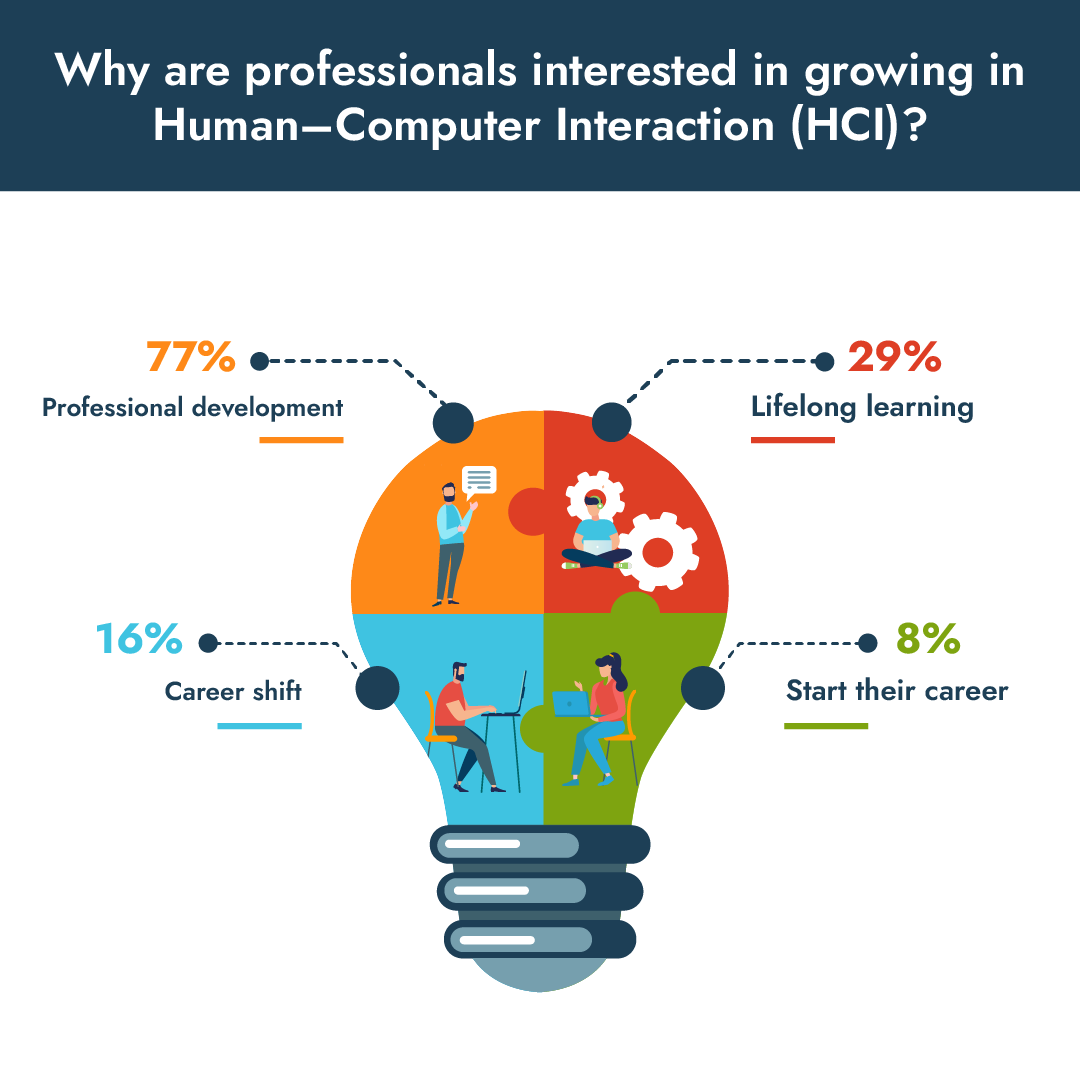Due to systems maintenance on the weekend of 25 - 27 April 2025, we can only accept payments by Visa, Mastercard and PayPal. We cannot accept discount codes. Apologies for any inconvenience.
AI and Data Science
The three skills that made 92% of surveyed Product Developers, Design Managers and System Designers progress their careers in HCI
AI and Data Science
The three skills that made 92% of surveyed Product Developers, Design Managers and System Designers progress their careers in HCI
Human-Computer Interaction (HCI) has emerged as an increasingly sought-after skill in various industries. In this article, we delve into the essential skills that have propelled 92% of surveyed Product Developers, Design Managers, and System Designers towards career progression in HCI.
What are the key skills needed to advance in HCI?
To answer this question, we wanted to approach Professor Per Ola Kristensson, Professor of Interactive Systems Engineering, Department of Engineering, from the University of Cambridge. A renowned expert in the matter, he leads the Intelligent Interactive Systems Group at the Cambridge Engineering Design Centre and is also a co-founder and co-director of the Centre for Human-Inspired Artificial Intelligence at the University of Cambridge.
His PhD thesis was on gesture keyboard technology, which he co-invented together with Dr Shumin Zhai in 2001-2002 and has since won international accolades for his contribution to the field of artificial intelligence.
Professor Per Ola Kristensson is the course lead of the course Human–Computer Interaction (HCI) for AI Systems Design by the University of Cambridge Online and recently led a webinar on HCI for AI Systems Design, and during this session he highlighted the critical skills necessary to progress in this field. These skills include:
Crafting Problem Statements for Human-AI Collaboration: Develop solutions that foster seamless interaction between humans and AI by crafting compelling problem statements.
Identifying and Mitigating Risks within the Human-AI Framework: Ensure systems meet diverse requirements and perfect validation and verification processes to mitigate risks.
Bridging the Gap between Demands and AI Capabilities: Design AI systems that align with user demands, integrating AI capabilities with an understanding of user behaviours.
Per Ola has elaborated on the following reasons for why these skills are crucial for advancing in the field of HCI:
Enhanced Collaboration: Crafting problem statements that inspire collaboration between humans and AI fosters a harmonious interaction between the two entities. This skill enables professionals to develop solutions that effectively leverage the strengths of both humans and AI, leading to more efficient and productive outcomes.
Risk Management: Identifying and mitigating risks within the human-AI framework is essential for ensuring the safety, reliability, and effectiveness of AI systems. Professionals with this skill can anticipate potential challenges and proactively implement measures to address them, thereby minimising the likelihood of adverse outcomes and enhancing user trust and satisfaction.
Alignment with User Needs: Bridging the gap between demands and AI capabilities involves designing AI systems that meet the diverse requirements and expectations of users. By understanding user behaviours, preferences, and needs, it is possible to develop AI solutions that deliver value and utility, thereby enhancing user experiences and driving positive outcomes.
Overall, mastering these skills empowers professionals involved in AI to navigate the complexities of HCI effectively, enabling them to develop innovative solutions, mitigate risks, and deliver impactful outcomes in an increasingly AI-driven world.
How to obtain the right skills in Human Computer Interaction
The University of Cambridge Online offers an HCI course led by Professor Per Ola: Human–Computer Interaction (HCI) for AI Systems Design. This course caters to individuals managing product design, development, and user experience across various industries, including manufacturing, technology, financial services, healthcare, and consumer or commercial products.
This course aims to offer the participants the following outcomes:
In-demand roles: Transition into very demanded positions like UX/UI Designer, AI Interaction Specialist, and HCI Researcher.
Industry impact: Lead innovative projects in tech, gaming, healthcare, and more, improving user experiences with AI.
Skill advancement: Enhance your portfolio with cutting-edge HCI techniques, making you a prime candidate for leadership roles in tech design and development.
Networking opportunities: Gain access to a global community of professionals and experts in HCI and AI for unparalleled career networking.
Impact on Past Learners' Career Progression
Human-Computer Interaction skills can benefit multiple roles. Past learners of the Human–Computer Interaction (HCI) for AI Systems Design course, including Senior Product Developers, Design Managers, and Lead System Designers, have seen significant career progression after completing the course.
Students of this course by the University of Cambridge Online come from a range of backgrounds, as shown below, most of them working in design and UX:
Design and User Experience: 41.30%
Engineering and Technology: 13.04%
Management and Leadership: 10.87%
Education and Research: 4.35%
Miscellaneous: 8.70%
This is what the learners, whose backgrounds were mentioned above, reported on their career progression:
92% applied their newfound knowledge and skills to their current roles.
59% applied their skills to new roles or projects.
92% felt more confident in their current roles and applying for new roles.
25% considered a career move into a different field.
What sort of background do I need to succeed in HCI?
During the webinar on Human–Computer Interaction (HCI) for AI Systems Design led by Professor Per Ola, attendees were asked about their familiarity with the subject and why they were interested on it, to be able to build a learner persona and discover who is really interested in growing in this field.
According to the questionnaire, 43% of respondents reported being somewhat familiar with HCI, indicating that deep knowledge of the subject is not a prerequisite for success in the course, with other percentages being represented as per the graphic below.

How familiar with Human–Computer Interaction (HCI) are potential learners?
Not familiar at all 14%
Somewhat familiar 43%
Moderately familiar 27%
Very familiar 12%
Extremely familiar 4%
When asked about their professional aspirations driving interest in HCI, 77% of respondents expressed a desire for professional development, highlighting the strong demand for skills that drive career progression in HCI.

Why are professionals interested in growing in Human–Computer Interaction (HCI)?
Professional development 77%
Career shift 16%
Start their career 8%
Lifelong learning 29%
Understanding what the three main skills to grow in HCI for AI Systems Design are was extremely revealing, but for us it was really interesting too to discover what type of roles demand further skills on HCI for AI Systems Design and what are their ambitions when pursuing this course.
For further insights into mastering HCI skills, watch the full webinar session with Professor Per Ola Kristensson(Opens in a new window).
We invite you to visit the Human–Computer Interaction (HCI) for AI Systems Design course that covers these three skills in detail and propel your career forward with the University of Cambridge Online.


